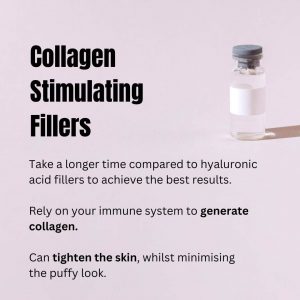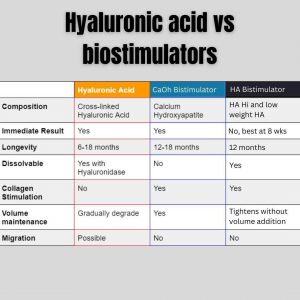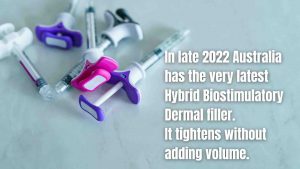Collagen Stimulating Fillers, At A Glance
- Best Results1-3 sessions
- Treatment Recovery0-3 days
- Procedure Time10- 30 minutes
- Skin SpecialistDermatologist, Davin Lim
- Duration of Results36-60+ months
- AnaestheticWithin the filler
- Back to WorkSame day
- Cost$$
Collagen stimulating dermal fillers
Collagen stimulating fillers are different in longevity & application compared to shorter-acting hyaluronic acid fillers. These groups of fillers give an immediate effect followed by long-term collagen stimulation. The most popular collagen-stimulating fillers in Australia include Polymer Injectable & Ca OH apatite. I primarily use these fillers in the jawline, and necklines & for volume replacement in the hands.
FactsFacts on Collagen Stimulating Skin Hydrator
- Collagen stimulating fillers include Poly-L-Lactic-Acid & Calcium Hydroxylapatite
- This family of fillers usually last twice as long compared to hyaluronic acid fillers
- Calcium hydroxyl apatite fillers can be used on the face, neck, & hands
- Specific dilutions, known as hyper-dilutions, gives bespoke formulations
- These fillers can give structure, volume & lift
- Collagen stimulating filler are also used to treat atrophic acne scars
- These fillers are often combined with energy devices including RF & HIFU to stimulate more collagen production
What is the difference between hyaluronic acid fillers & collagen stimulating fillers?
Collagen Stimulating Skin Hydrator
Hyaluronic acid fillers are the most widely used fillers in Australia. This family of fillers are made up of cross-linked sugar molecules. Whilst these filters can provide support & volume, their longevity varies from 6 to 24+ months. Some types of collagen-stimulating fillers provide better structure & volume in comparison to HA fillers.

I employ different fillers, including HAs, non-HAs, dermal grafting & fat transfer procedures depending on the job required. Each type of ‘filler’ has pros & cons. Hyaluronic acid fillers are reversible, collagen-stimulating fillers are not (though there are case reports of Radiesse filler being reversed by sodium thiosulfate).
How do collagen fillers work?
These fillers work in two ways, firstly to add volume, then to stimulate collagen. This skin hydrating treatment temporarily adds volume to help smooth facial wrinkles & gives an immediate lifting & firming effect of the skin.
Once injected, calcium hydroxyl apatite directly provides volume & lift, it contains carefully formulated calcium-based microspheres and a gel. Both the gel & the microspheres are completely broken down by the body over time.
More on how this filler works https://radiesse.com/how-it-works/
What areas can collagen stimulating dermal fillers treat?
In my practice I use these specific fillers for –
Jawline contouring: For this area I want as much lifting capacity, longevity & volume as possible! Typically, jawline contouring requires between 4-6 ml of hyaluronic acid fillers, with filler longevity lasting 2 years plus. On this basis, the use of collagen stimulating fillers can replenish & reshape this area safely & efficiently with the added bonus of longevity.

Temple shaping & volume: As with jawlines, large volumes are often required in this area, especially in atrophic & hollowed ‘pinched’ temples.
Volumetric filling: Poly-L-Lactic-Acid can be used for large volume deficits. One vial of Polymer Injectable is 9 ml, compared to one syringe of filler- one ml. For patients who are extremely atrophic (gaunt-thin-low-fat), collagen fillers have a distinct advantage over HA fillers. I do employ Polymer Injectable fillers in hyper-dilute concentrations – usually 1:18 ratio.
Hand rejuvenation: As one ages, we lose both collagen & fat, the hands are no exception. Hand rejuvenation is based upon volumetric filling to reduce the skeletal look of tendons, in addition to restoring dermal thickness. My most frequent combination is with a bespoke dilution of collagen stimulating filler with fractional laser resurfacing to improve skin quality. In this location, collagen stimulation also improves dermal & epidermal thickness.
Acne scars: Scar revision largely relies on your immune system to regenerate & remodel collagen. For mild to moderate scars, the majority of patients can replenish collagen through a process known as neocollagenesis. For larger volume deficits, I use a predetermined formulation of collagen stimulating fillers to help repair ‘atrophic’ areas & kick start the immune system to regenerate collagen.
How long do fillers last?
Calcium hydroxyl apatite & poly-L-lactic acid fillers typically last between 36 to 60 months, depending on the area treated, dilution, & individual factors (such as your immune system & metabolism).
In hyper-dilute concentrations the longevity ranges between 1 to 3+ years.


View our Treatment Gallery
Is the treatment painful?
Treatments are super comfortable as I reconstitute these fillers with local anaesthetic numbing agents. These fillers, when formulated correctly, give the same sensation as with hyaluronic acids.
What are the benefits of collagen stimulating fillers over hyaluronic acid dermal fillers?
There are many factors that go into the decision of when, where, & how to employ longer lasting collagen stimulating fillers over a hyaluronic acid filler.
I am mindful of employing different classes of fillers based upon factors listed below. The most important factor to consider is patient safety, for example, in my practice I only use hyaluronic acid fillers in areas such as the nose, under the eyes (tear trough, with exception of those who Tyndal, in this context I may use a hyper-dilute solution of Ca OH Apatite), & lips. These are ‘higher risk’ areas where in the unlikely event I require reversal, an enzyme is readily available.

On the flipside, I would consider longer lasting collagen stimulating dermal fillers in areas such as jawline rejuvenation, as well as the temples. In this context Polymer Injectable & Ca OH fillers have advantages over traditional Hyaluronic Acids.
| Class of Filler | Longevity | Safety | Finesse | Costs over time |
| Hyaluronic Acid | 6 months to 24 months | Reversal enzyme avail. | Great for finesse & contrours | $$$$ |
| Collagen Stimulating | 36 to 60 months plus | No reversal enzyme | Great for volume & lift | $- $$ |




Can these fillers be mixed with traditional hyaluronic acid dermal fillers?
Yes, they can, just as long as sessions are spaced apart. I do however use both classes of fillers in the same session if they are not layered. An example is the use of Radiesse for the angle of the jaw, & hyaluronic acid fillers for the chin. Many sensible combinations are possible.
What about fat grafting & fat transfer?
I started fat transfer in 2010 however I have not been impressed with the results. My practice is based upon the predictability of success of each procedure. In the past, fat transfer has had the reputation of unpredictability due to variable rates of fat absorption.
In the past 4 years we have refined this procedure to make fat transfer & grafting more predictable (though not as predictable as dermal fillers). In some cases of large volume replacements (acne scars, temples), fat transfer may be a viable option. Review the landing pages on fat transfer & stem cells on this website.
What are the risks of dermal fillers?
Careful injecting with excellent product & anatomical knowledge will markedly reduce but not eliminate side effects. HA or hyaluronic acid fillers are reversible with an enzyme called Hyalase, whilst collagen stimulating fillers such as Polymer Injectable (Poly-L-Lactic-Acid) & calcium hydroxyl apatite do not have a reliable reversal agent. On this basis I am extremely careful, & selective where I employ these families of dermal fillers.
Delayed nodules, infection, & biofilm are very rare side effects. The decision to employ collagen stimulating fillers is based upon calculations of risks & benefits taking into consideration clinical findings, technique, anatomy, & dilution.
What are the costs of these fillers & how much volume will I require?
Collagen stimulating fillers are more cost effective compared to HA fillers as you get more volume & longevity. On label volumes range from 1.5ml to 9ml, depending on the type. HA fillers come in 1ml syringes.
The amount or volume required depends on the area treated. As a guide, cheeks require 1.5 to 3 mls, temples 3 mls to 4.5 mls, whilst jawline contouring requires 4.5ml to 7.5ml.

Davin’s take on collagen stimulating fillers
Imagine painting with 4 colours. It can be done, but chances are the painting is pretty ordinary. Same goes with dermal fillers. It is super important to familiarise oneself with a spectrum of dermal fillers, including different brands in addition to different classes. A company does not make the best portfolio out there; hence why I work with many different brands including Allergan, Merz, Restylane, Teoxane, & others. The same goes for using different classes of fillers, hence why I frequently employ collagen stimulating fillers. Pick the correct filler for the job, & not limit one’s selection based upon training.
Collagen stimulating fillers have 3 distinct advantages when employed correctly, firstly longevity. These last upward of 5+ years, compared to 2+ years with HA fillers. Secondly volume & costs. For example, consider the jawline area where it is not uncommon to use upwards of 6mls of HA fillers (for a perspective, a teaspoon is 5mls, so 6 syringes in this area is not uncommon). The use of calcium hydroxyl apatite in this area really makes sense as it has the highest “G prime” (lifting capacity, third reason), coupled with volume & longevity. The use of cannula gives a much higher level of safety compared to needles.

In my practice for every 4 to 5 boxes of HA fillers, I employ one vial-syringe of collagen stimulating filler. The ratio changes when I treat acne scar as I tend to use more hyper diluted calcium hydroxyl. The great thing about these fillers is that I can mix them with a bespoke dilution of choice.
